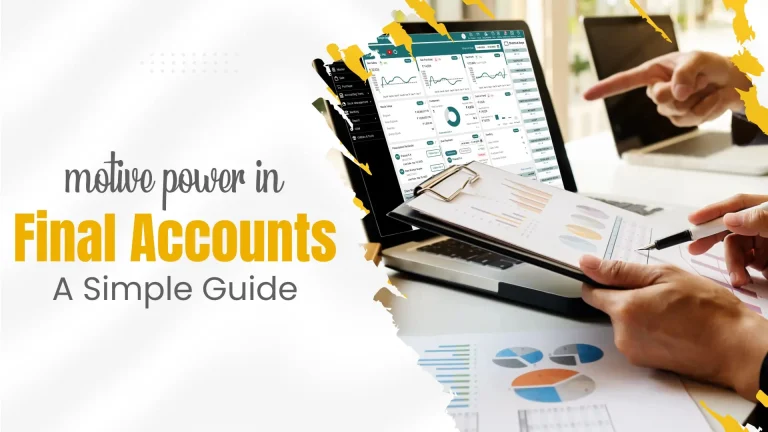Motive power, an essential part of many businesses, especially those involved in manufacturing and production, plays a significant role in the final accounts. Final accounts include the balance sheet, income statement, and cash flow statement, all of which provide a complete picture of a company’s financial performance and position. Understanding how motive power affects these accounts is vital for accurate financial reporting and effective decision-making. In this detailed discussion, we will explore the significance of motive power in final accounts, its impact on various financial statements, and best practices for accounting it accurately.
What is Motive Power?
Motive power refers to the energy required to operate machinery and equipment in a business. This can include electricity, fuel, steam, and other forms of energy used to drive machines that perform various production processes. In a manufacturing setup, motive power is a significant cost component and directly affects the cost of goods manufactured. Properly accounting for motive power is crucial for determining the actual cost of production and, consequently, the pricing of finished goods.
Importance of Motive Power in Final Accounts
Motive power’s importance in final accounts cannot be overstated. It influences several aspects of financial statements, and its accurate accounting is essential for the following reasons:
- Cost of Goods Sold (COGS): Motive power costs contribute significantly to the COGS. Incorrect accounting of these costs can lead to misstated COGS, affecting gross profit calculations.
- Expense Allocation: Properly allocating motive power expenses ensures accurate expense reporting, which is essential for analyzing operational efficiency.
- Asset Valuation: Machinery and equipment’s operational efficiency and lifespan can be affected by motive power usage, impacting depreciation and asset valuation.
- Budgeting and Forecasting: Understanding motive power costs aids in creating more accurate budgets and financial forecasts, helping businesses plan for future energy needs and costs.
Components of Motive Power Costs
To fully understand the impact of motive power on final accounts, it’s essential to break down the components of motive power costs. These include:
- Direct Costs: These are costs directly associated with operating machinery, such as electricity bills, fuel expenses, and costs of steam or other energy sources.
- Indirect Costs: These include costs related to maintaining and servicing the power systems, such as generator maintenance, repairs, and depreciation of power generating equipment.
- Fixed Costs: Costs that do not vary with production levels, such as fixed charges for power supply or minimum fuel purchases.
- Variable Costs: Costs that vary directly with the level of production, such as fuel consumption directly linked to machinery usage.
Accounting for Motive Power in Final Accounts
Accurate accounting of motive power costs requires meticulous recording and allocation. Here’s how businesses typically account for motive power in their final accounts:
Recording Direct Costs
Direct costs of motive power are recorded as part of the manufacturing overhead. These costs are then allocated to the cost of goods manufactured based on the amount of power consumed by each production unit. This allocation can be done using various methods, such as:
- Direct Measurement: Using meters to measure the exact amount of power consumed by each machine or production process.
- Estimation: Estimating power consumption based on machine hours or production units.
- Apportionment: Allocating costs based on a pre-determined formula or ratio.
Indirect Costs Allocation
Indirect motive power costs are typically included in the overall manufacturing overhead and apportioned to different cost centers. This can be done using cost drivers such as machine hours, labor hours, or production units. Accurate allocation ensures that each product bears its fair share of the overhead, leading to precise costing and pricing.
Depreciation and Asset Valuation
Motive power also affects the depreciation of machinery and equipment. Regular use of motive power can lead to wear and tear, affecting the useful life of assets. Depreciation methods such as the straight-line method or the reducing balance method can be used to account for this. Accurate depreciation accounting is vital for asset valuation on the balance sheet and for calculating net profit.
Impact on Financial Statements
Motive power has a direct and significant impact on all three primary financial statements:
- Income Statement: The cost of motive power affects the income statement through COGS and operating expenses. High motive power costs can reduce gross profit and operating profit, affecting the overall profitability of the business.
- Balance Sheet: Depreciation of machinery and equipment due to motive power usage affects the balance sheet. It reduces the book value of assets and affects the net worth of the business.
- Cash Flow Statement: Motive power costs impact the cash flow from operating activities. Efficient management of these costs can improve cash flow, while high or poorly managed costs can strain the cash resources of the business.
Best Practices for Managing Motive Power Costs
To ensure accurate accounting and control of motive power costs, businesses can adopt several best practices:
- Energy Audits: Regular energy audits help identify areas of inefficiency and potential cost savings.
- Efficient Equipment: Investing in energy-efficient machinery and equipment can reduce power consumption and costs.
- Maintenance: Regular maintenance of machinery ensures optimal performance and prevents energy wastage.
- Monitoring and Control: Implementing systems for monitoring and controlling energy usage can help in keeping track of power consumption and costs.
- Negotiating Power Rates: Negotiating better rates with power suppliers can result in significant cost savings.
Future Trends in Motive Power Accounting
As we look towards the future, several trends are likely to influence the way motive power is accounted for in final accounts. These include advancements in technology, increasing emphasis on sustainability, and regulatory changes.
Technological Advancements
With the rapid advancement of technology, businesses have access to more sophisticated tools for monitoring and managing energy consumption. Smart meters, IoT devices, and advanced energy management systems can provide real-time data on power usage, enabling more accurate accounting and better decision-making. Automation and AI can also play a significant role in optimizing energy usage and reducing costs.
Emphasis on Sustainability
As the world moves towards sustainable practices, businesses are increasingly focusing on reducing their carbon footprint and adopting green energy solutions. Renewable energy sources such as solar, wind, and biomass are becoming more popular. Accounting for these alternative energy sources may require new methodologies and practices, but they also offer opportunities for cost savings and improved corporate social responsibility.
Regulatory Changes
Governments worldwide are implementing stricter regulations related to energy consumption and reporting. Compliance with these regulations requires businesses to maintain accurate records of their energy usage and associated costs. Staying updated with regulatory changes and adapting accounting practices accordingly is crucial for businesses to avoid penalties and ensure compliance.
Conclusion
In this comprehensive discussion on motive power in final accounts, we’ve explored its significance, impact on financial statements, components, accounting methods, and best practices for management. Understanding and accurately accounting for motive power is essential for businesses to ensure accurate financial reporting, cost control, and efficient operations. As technology advances and sustainability becomes a priority, businesses must adapt their accounting practices to stay competitive and compliant with regulatory requirements. Try online accounting software for easy accounting.
By implementing effective strategies for managing motive power costs, businesses can not only enhance their financial performance but also contribute to a more sustainable future. The role of motive power in final accounts is multifaceted, and its proper management is key to achieving long-term business success.
Also Read:
- What Should You Look for in Accounting Programs for Small Business?Depending on a good selection of Accounting Programs for Small Business, you can succeed or not. The small business owners can easily keep a record of expenditure, automate their bills, and remain compliant with appropriate tools. Nevertheless, not every accounting… Read more: What Should You Look for in Accounting Programs for Small Business?
- How Do Accounting Platforms Improve Financial Accuracy in 2025?The financial accuracy is more than just a buzzword – it’s the backbone of smart decision-making. As we step further into 2025, businesses are no longer relying solely on manual bookkeeping or outdated systems. Instead, they’re embracing modern accounting platforms… Read more: How Do Accounting Platforms Improve Financial Accuracy in 2025?
- Why Is It Important to Understand the Account Golden Rules with Example?When it comes to managing business finances in India, understanding the account golden rules with examples is essential, especially for startups, small business owners, and even freelancers. No matter how big or small your venture is, the fundamentals of accounting… Read more: Why Is It Important to Understand the Account Golden Rules with Example?
- Why Are the Accounting Three Golden Rules Still Relevant Today?The various accounting practices continue to play a crucial role in managing the financial health of organizations. Whether it’s a small startup or a multinational corporation, accurate financial reporting and decision-making are vital. While technology has drastically transformed accounting, some… Read more: Why Are the Accounting Three Golden Rules Still Relevant Today?
Frequently Asked Questions
What is motive power in final accounts?
Motive power is the energy used to run machines in a business. This energy can be from electricity, fuel, or steam. In final accounts, motive power costs are important because they affect how much it costs to make goods, the company’s expenses, and how much profit it makes. It’s crucial to record these costs accurately to understand the business’s finances well and make good decisions.
How does motive power affect the income statement?
Motive power costs directly impact the income statement by increasing the cost of making goods and other business expenses. High costs from motive power can lower the profit the company makes from selling goods. Accurate accounting helps show the true profit and helps businesses plan better.
Why is accurate accounting of motive power important?
Accurate accounting of motive power is vital because it shows exactly how much it costs to run machines and make goods. It helps set the right prices for products and plan the budget. Accurate records also help the business follow rules and plan for the future.
What are the components of motive power costs?
Motive power costs include direct costs, like electricity and fuel used directly in production. Indirect costs include things like maintenance and repairs for machines. There are also fixed costs, which don’t change with production, and variable costs, which change based on how much is produced. Understanding these costs helps plan budgets and set prices.
How are motive power costs allocated in final accounts?
Motive power costs are divided up in final accounts by measuring how much each machine uses. This can be done with meters or by guessing based on how much is made. Accurate allocation makes sure every product or part of the business pays its fair share of the costs.
How does motive power impact the balance sheet?
Motive power affects the balance sheet by lowering the value of machines and equipment over time. This is called depreciation. It also affects how much the business owes for power. These things affect how much the business is worth.
What are best practices for managing motive power costs?
Best practices for managing motive power costs include checking energy use often, buying machines that use less power, and keeping machines in good shape. Monitoring and controlling energy use helps save money. Negotiating better deals with power companies can also help cut costs.
How can technology help in managing motive power costs?
Technology helps manage motive power costs by tracking energy use better. Smart meters and computer programs can show how much power is used right away. Machines can be made to use less power, and computers can help find ways to save even more. This helps save money and run the business better.
What is the role of sustainability in motive power accounting?
Sustainability is important in motive power accounting because it helps use less power and be better for the environment. Using renewable power like solar and wind can cost less and be better for the Earth. Making sure to count this power right is new but can save money and help the business look good.
What future trends will impact motive power accounting?
In the future, new technology will help track and use power even better. More businesses will use renewable power like solar and wind. Rules about using power and counting it will get stricter. Staying on top of these trends will help businesses save money and follow the rules.





